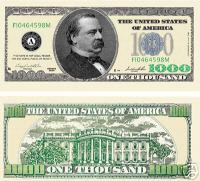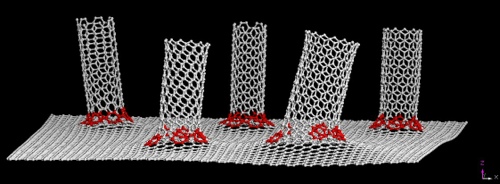Think of this as Volume 17, Number 9 of A-Clue.com, the online newsletter I've written since 1997. Enjoy.
Change can be slow, and change can be
sudden.
Those who practice the theory of “oh
noes,” the idea that it's all about to go pear-shaped, either see
slow change that can't be undone, or a sudden change that others see
as unlikely.
The people I meet on Seekingalpha.com,
the ones who are certain that we're about to go into another Great
Depression, believe in sudden change. Those who talk about climate
change tend to see slow change that can't be undone.
But most of the time, disaster does not
strike. And sudden change can be good as well as bad.
This is one of the great things about
being a science reporter, the idea that someone, somewhere, might
suddenly come up with a mighty idea, one that will drive out big
problems at a stroke.

campus of UCLA, in the lab of a scientist named Richard Kaner. He's
known around campus as Ric, and he's been at UCLA since 1987. He's best known there as a great teacher, someone who can make the
complex seem simple. Most of his lab's work involves studying
nanowires, and how electricity courses through various materials.
Kaner has drawn a fierce little cadre
of graduate students to him, one of whom is named Maher El-Kady. (Left, from UCLA.) A native of Egypt, and a doctoral candidate, he was working
with graphene, a form of carbon I'd describe as a carbon nanotube
laid on its side. It's a single atom thick, but its lattice structure
makes it a great superconductor. The two British scientists who
discovered it were given the 2010 Nobel Prize in Physics for their
discovery.
Lots of people are working with
graphene.

hybrid of graphene and nanotubes (they're known on campus as Buckytubes, and are closely related to
the Buckyball for which two Rice scientists got the 1996 Chemistry
Nobel). Dr. Tour explained that the lab created graphene on a
copper substrate, then grew nanotubes on top of the graphene.
Now back to UCLA. Copper is
inexpensive, but could you create graphene with some other substrate?
El-Kady found he could, very easily. He laid down a film of cheap
graphite oxide onto a DVD. Then he placed the DVD onto the bed of a
cheap LightScribe DVD burner. Instead of etching 1s and 0s onto tin
foil, as it would do in making a standard DVD, he was able to get the
burder to create small squares of pure graphene.
These squares could then be cut out and turned into the bread of an
electronic sandwich acting as a super-capacitor, capable of handling
far more electricity than anything else known to man.
Cool. A great solution for low-power
devices. Capacitors charge much more quickly than batteries, so these
cheap DVD-made capacitors would be perfect for phones, a power source
that might last as long as the phone itself without re-charging. Or
they could be made part of a mote or sensor, so that the Internet of
Things has long-lasting power.
Trouble is, how do you scale that up?
Simple. You combine the two techniques. You build graphene on cheap
substrate, from graphite oxide, as UCLA did, then you tease out
nanotubes as Rice did, and now you have a dirt cheap material with a
surface area of over 2,000 square meters per gram,
a graphene super-capacitor that can hold an enormous amount of
electricity for its weight.
That's what you need to replace the
lithium-ion batteries on the Boeing Dreamliner. That's what you need
to replace the lithium-ion batteries in Tesla motorcars. That's what
you need to store the enormous amounts of solar power that grid isn't
using today.

market are financial. Research labs like those of UCLA and Rice exist
to commercialize their discoveries, to license the patents their
researchers come up with. You have two seperate, but related
inventions here, each worth a fortune to one company, if they're
licensed that way. Or you have one huge invention that could change
the world, and quite quickly, if it's licensed broadly, without
exclusivity. The question for both schools is whether they can make
more money treating their inventions as “intellectual property”
or as scientific discovery for the good of all.
The answer to that is obvious. But
getting the universities to see that is going to be very difficult.
It's going to take some public pressure to get non-exclusive
licensing, essentially an industry standard like WiFi rather than a
patented monopoly like Lipitor.
And this is where we get back to the
nature of change. It can be fast, or it can be slow. It can be
negative, or it can be positive. But it can also be slowed-down or
sped up by how we treat discovery, as public policy. And how those
who control such discoveries choose to treat it.
What this all tells me is that the
intractable problem of energy storage, for electric cars, for phones,
and for solar abundance has been solved. The only question becomes
how quickly we can get it to market, and at what cost in terms of
dollars and principles.












One thing they would do well to remember is that it is not uncommon for discoveries to happen simultaneously in different parts of the world so the quicker they resolve the “to market” issues the better it will be for them and everyone else. Thanks for the great post!
One thing they would do well to remember is that it is not uncommon for discoveries to happen simultaneously in different parts of the world so the quicker they resolve the “to market” issues the better it will be for them and everyone else. Thanks for the great post!
This really opened my mind to some things. Thanks for taking the time to make this awesome blog. Will be back for sure.
This really opened my mind to some things. Thanks for taking the time to make this awesome blog. Will be back for sure.